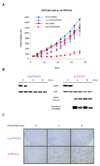PIK3CA mutation uncouples tumor growth and cyclin D1 regulation from MEK/ERK and mutant KRAS signaling
- PMID: 20699365
- PMCID: PMC3178450
- DOI: 10.1158/0008-5472.CAN-10-0409
PIK3CA mutation uncouples tumor growth and cyclin D1 regulation from MEK/ERK and mutant KRAS signaling
Abstract
Mutational activation of KRAS is a common event in human tumors. Identification of the key signaling pathways downstream of mutant KRAS is essential for our understanding of how to pharmacologically target these cancers in patients. We show that PD0325901, a small-molecule MEK inhibitor, decreases MEK/ERK pathway signaling and destabilizes cyclin D1, resulting in significant anticancer activity in a subset of KRAS mutant tumors in vitro and in vivo. Mutational activation of PIK3CA, which commonly co-occurs with KRAS mutation, provides resistance to MEK inhibition through reactivation of AKT signaling. Genetic ablation of the mutant PIK3CA allele in MEK inhibitor-resistant cells restores MEK pathway sensitivity, and re-expression of mutant PIK3CA reinstates the resistance, highlighting the importance of this mutation in resistance to therapy in human cancers. In KRAS mutant tumors, PIK3CA mutation restores cyclin D1 expression and G(1)-S cell cycle progression so that they are no longer dependent on KRAS and MEK/ERK signaling. Furthermore, the growth of KRAS mutant tumors with coexistent PIK3CA mutations in vivo is profoundly inhibited with combined pharmacologic inhibition of MEK and AKT. These data suggest that tumors with both KRAS and phosphoinositide 3-kinase mutations are unlikely to respond to the inhibition of the MEK pathway alone but will require effective inhibition of both MEK and phosphoinositide 3-kinase/AKT pathway signaling.
Figures






References
-
- Shields JM, Pruitt K, McFall A, Shaub A, Der CJ. Understanding Ras: 'it ain't over 'til it's over'. Trends Cell Biol. 2000;10:147–154. - PubMed
-
- Campbell PM, Der CJ. Oncogenic Ras and its role in tumor cell invasion and metastasis. Semin Cancer Biol. 2004;14:105–114. - PubMed
-
- Bowen DT, Frew ME, Hills R, et al. RAS mutation in acute myeloid leukemia is associated with distinct cytogenetic subgroups but does not influence outcome in patients younger than 60 years. Blood. 2005;106:2113–2119. - PubMed
-
- Repasky GA, Chenette EJ, Der CJ. Renewing the conspiracy theory debate: does Raf function alone to mediate Ras oncogenesis? Trends Cell Biol. 2004;14:639–647. - PubMed
-
- Moodie SA, Willumsen BM, Weber MJ, Wolfman A. Complexes of Ras.GTP with Raf-1 and mitogen-activated protein kinase kinase. Science. 1993;260:1658–1661. - PubMed
Publication types
MeSH terms
Substances
Grants and funding
LinkOut - more resources
Full Text Sources
Other Literature Sources
Research Materials
Miscellaneous

